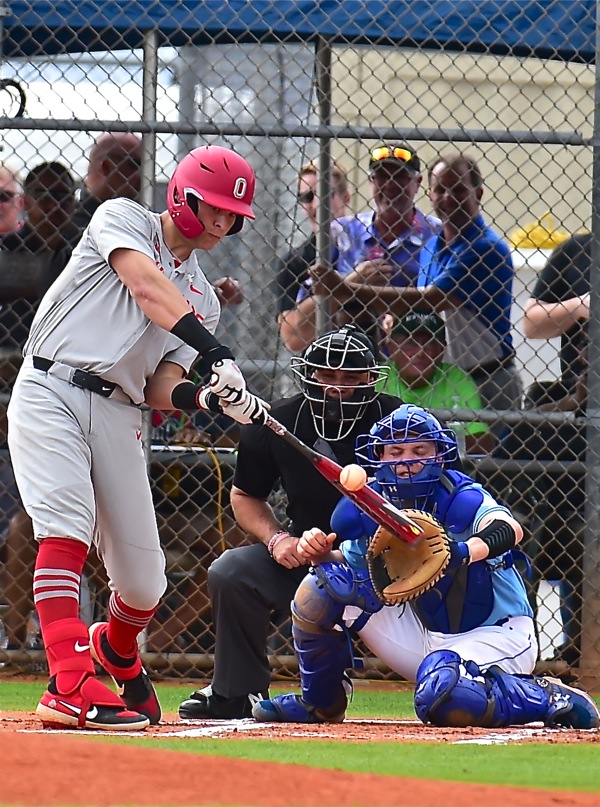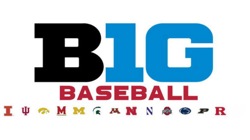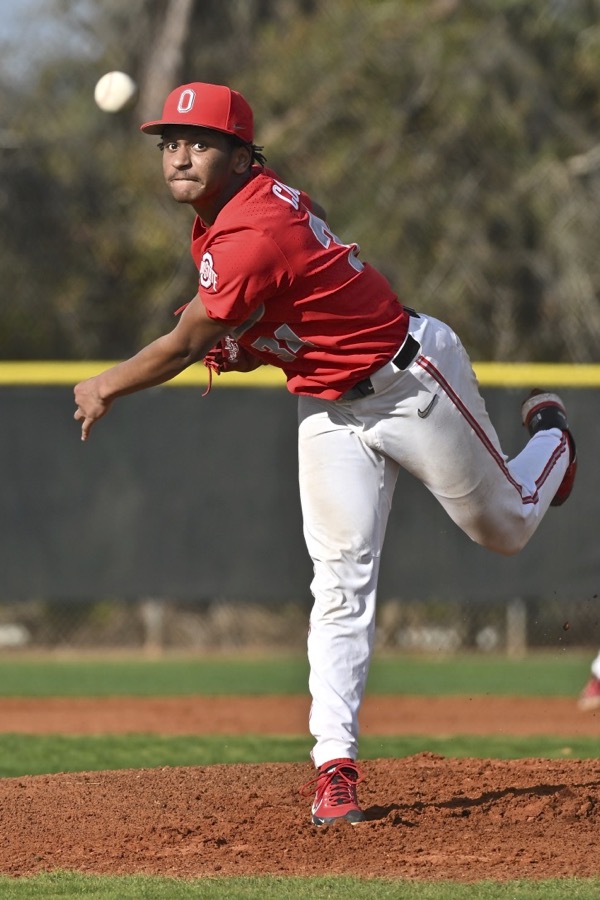One of the toughest things in baseball is to learn the difference in throwing, and ‘pitching’. And once you get it down, it’s like working a crossword puzzle from 60 feet, 6 inches.
 North Port, FL – The first words out of Greg Beals’ mouth following Friday’s weekend-opening win over Marshall were, “It starts on the mound”, referring to sophomore starter Ike Coupet’s six innings of 2-hit, 11-strikeout baseball.
North Port, FL – The first words out of Greg Beals’ mouth following Friday’s weekend-opening win over Marshall were, “It starts on the mound”, referring to sophomore starter Ike Coupet’s six innings of 2-hit, 11-strikeout baseball.
Coupet was dominant, but hardly overpowering. He didn’t have to be. He was smart.
He doesn’t throw the ball 95 miles per hour, like TJ Brock or freshman left-hander Gavin Bruni. Still, statistically the scorebook made it look like a mismatch against Marshall, a team that for years has had the reputation for hitting now and asking questions later. They hunt fastballs.
There’s more than one interpretation for the words, “It starts on the mound”. Fundamentally, it means that pitchers have to throw strikes and challenge the hitters to swing…because the worst thing in baseball is the base on balls – walks – and physical and psychological impact it has on a team’s ability to compete.
 But secondary, “It starts on the mound” means that a pitcher believes in his ability to execute and compete, that what he throws is good enough to create advantage and deception enough to make batters uncomfortable, and to make them miss.
But secondary, “It starts on the mound” means that a pitcher believes in his ability to execute and compete, that what he throws is good enough to create advantage and deception enough to make batters uncomfortable, and to make them miss.
Coaches call it ‘trusting your stuff’, meaning that you know your fastball is going to sink, rise, tail, or have enough late finish to beat the bat – that your secondary pitches are good enough to deceive. Isaiah Coupet was able to do that Friday.
“We had a plan in the bullpen,” said Coupet of himself and pitching coach Dan DeLucia. “And it worked.
What he did was throw his best pitch, the curve, with purpose. He threw it early in the count, he threw it late in the count…he threw it whenever he wanted. But he threw it confidently, and enough that Marshall hitters never really knew what was coming. And when he did throw the fastball, it looked like special delivery from Nolan Ryan.
When I played college baseball I knew that I didn’t throw hard enough to dominate hitters at that level, not like in high school. And like Coupet, I liked to throw the curve. What I found was…when I threw it for a strike on the first pitch hitters wouldn’t swing at it because they wanted to hit a fastball.

It’s the natural instinct of hitters to look for, and time up the fastball. The trick is to upset their timing. Connor Pohl (above) hits one out during 2019’s Snowbird Classic.
Realizing that, I learned to throw it again for strike two. And still they took it, still waiting on the fastball. Statistics say that when a pitcher is ahead 0-2 the probabilities are about 80% in his favor of getting a hitter out. What I found was that when I did throw the fastball I didn’t even have to throw it for a strike. Hitters were so anxious they’d swing at it out of the strike zone and get themselves out.
This is an important interpretation of “it starting on the mound”, what you learn about your ability to compete aside from the physical wrestling match of trying to win with the fastball. Once you learn you don’t have to, pitching becomes easier, and fun – like a crossword puzzle from 60 feet, 6 inches.
It’s not always that easy, and it comes to different pitchers at different points in their development. And frankly, it’s hard to withstand the temptation to just stand out there and try to throw the ball past the hitter, because that’s an instinct you learn in Little League. The bigger, stronger, kids CAN throw the ball past the weaker, smaller kids.
But as you grow the tables turn. That same hitter grows, too, gets stronger, and soon he’s able to catch up with the fastball. And that’s when you have to learn to ‘pitch’.
First, you have to overcome your emotions – nerves – and any doubts that you can do it. Coupet mentioned in Friday’s game story that it was something he worked on all through fall baseball to prepare for that moment he experienced against Marshall. He assured…he wasn’t nervous!
Second, you have to have done the work…confident in your ability to throw with a repeatable motion. Smarter people would call it muscle memory, but really it’s just a habit and co-ordination you develop – like riding a bicycle or swimming.
 And last, you learn to rely on your brain as much as you do your arm. Control your emotions, settle down, and learn to think better than the hitter. If he’s thinking fastball you throw something else, because baseball’s predictable that way. If the count’s 3-0 it’s called a fastball count for a reason. And sometimes the hitter thinks like you do as a pitcher and beats you, and you just tip your hat. That’s baseball, too.
And last, you learn to rely on your brain as much as you do your arm. Control your emotions, settle down, and learn to think better than the hitter. If he’s thinking fastball you throw something else, because baseball’s predictable that way. If the count’s 3-0 it’s called a fastball count for a reason. And sometimes the hitter thinks like you do as a pitcher and beats you, and you just tip your hat. That’s baseball, too.
Good pitching almost always beats good hitting, because, hitters’ instinct is to hunt for the fastball. And that’s why Greg Beals, and thousands like him, say, “It starts on the mound”.
And now you know what that means.

Isaiah Coupet threw the curve Friday whenever he wanted. But he threw it confidently, and enough that hitters couldn't guess what was coming. (Press Pros Feature Photos)


